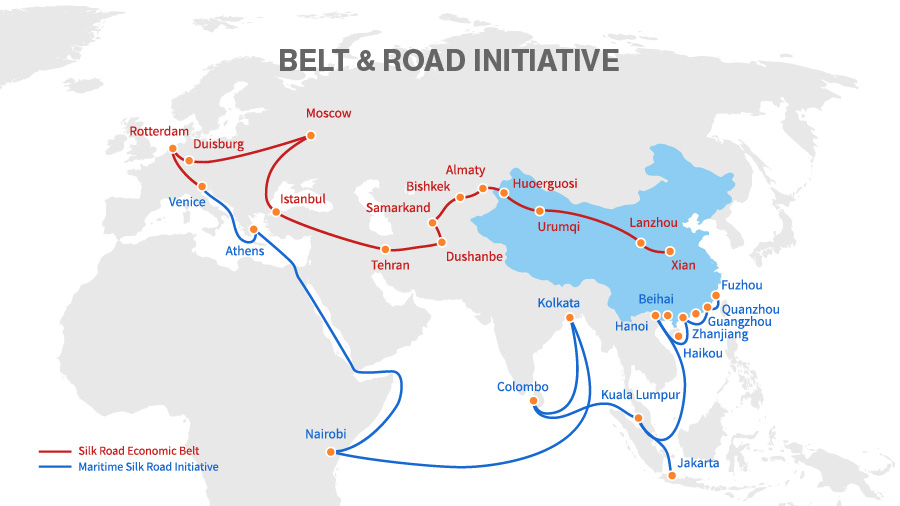China’s Soft Development Strategy for the Belt and Road Initiative

China’s Center for China and Globalization, a leading independent think tank based in Beijing, has released a series of suggestions for the development of the Belt and Road Initiative. The CCG research agenda centers on China’s growing role in the world, drawing from issues of global migration, foreign relations, international trade and investment, homegrown multinational companies (MNCs) and other topics pertaining to regional and global governance, while its members include several prominent Chinese officials, such as Long Yongtu, former Vice Minister of the Chinese Ministry of Commerce and chief negotiator for China’s accession into the WTO and He Yafei, former Vice Minister of the Chinese Ministry of Foreign Affairs, among many others.
The CCG recommendations include the development of a new international cooperation platform that should be permanently established for the Belt and Road Initiative, along with ten other pointers to develop this under the Belt and Road Initiative. These include:
- A legal framework for international governance
- Establish an international council to coordinate relations between BRI countries;
- Draft a ‘Belt and Road’ Charter to develop fair and mutually beneficial security conditions; and
- Establish an international law commission and an overarching dispute settlement center to form a new order of regional governance.
- Strengthen cooperation with UN, World Bank, IMF, WTO, and other international organisations
- BRI’s vision is consistent with the goals of UN’s 2030 Agenda for Sustainable Development; and
- BRI requires support from professional talent in various fields and should cooperate with International Labor Organisation and International Organisation for Migration.
- Invite developed countries, such as the EU, Japan and South Korea to participate in the initiative
- Deepen cooperation with key countries
- An example: the UK is more experienced than China in legal and financial services, and its participation as a third party could benefit market cooperation
- A permanent body for the Belt and Road Initiative
- A permanent secretariat should be set up to facilitate the advancement of projects; and
- Countries can take turns to host an annual meeting for think tanks to exchange ideas.
- An international enterprise alliance to attract the world’s top 500 companies to participate in BRI
- Businesses are encouraged to join the alliance, focusing on development, industry, border trade, science and technology, logistics, finance, tourism, and cultural exchange; and
- The alliance can organize international forums, such as a manufacturing summit, an SME Summit, an MNC and SME cooperation forum, etc. to facilitate exchange of ideas.
- Certain countries and demonstration projects should be held up as role models for future endeavors
- Development districts and industrial zones in Pakistan, India, Kazakhstan, Kyrgyzstan and Mongolia can be potential choices; and
- continuously expand financing channels and innovate financing schemes.
- Focus on developing overseas economic and trade cooperation zones and parks
- The number of cooperation zones under construction has increased significantly in BRI countries, accounting for 75 percent of all zones under construction by Chinese contractors;
- These zones contributed US$1.07 billion in taxes in 2016 to host countries and created 177,000 jobs for local people, this level increases to rise; and
- This can help China’s competitive industries achieve agglomeration overseas and accelerate the industrialization process for host countries.
- Give full play to the role of overseas Chinese in international cooperation
- Overseas Chinese are encouraged to develop and operate overseas cooperation zones, build CBEC demonstration bases, conduct nongovernmental diplomacy and cultural exchanges, promote information exchange and resource sharing, and expand financing channels.
- A ‘digital Silk Road’ should take advantage of China’s leading internet technology, big data technology and CBEC development
While some of these initiatives have already been partially implemented, such as the establishment of “Belt and Road Dispute Courts“, many of the other suggestions, such as a much-needed secretariat, have not materialized. As is often the case in China, there are likely to be power struggles, in this instance between the Ministry of Foreign Affairs and Ministry of Commerce over who is responsible for such a body. Budgeting for it would also be a Chinese political issue.
Other notable suggestions include the Belt and Road Initiative to liaise with international bodies responsible for monitoring human migration and labor, suggesting the authors are aware that the Belt and Road will create both temporary and potentially permanent resettlement of people across Eurasia and possibly Africa. This will come about as Chinese workers are sent abroad on projects, some will inevitably remain. Also of note is the suggestion that the Belt and Road Initiative follows the goals of the United Nations’ 2030 Agenda for Sustainable Development. In fact, that suggestion has already been implemented, with a 2017 UNDP report Identifying Development Dividends along the Belt and Road Initiative already having been released. This was followed by a further meeting concerning the Belt and Road Initiative and the UN Economic Analysis and Policy Division being held in June this year. A summary of that can be found here.
Other initiatives are more fairly obvious, such as working more closely with global financial and development institutions, such as the World Bank, IMF, and WTO.
Chris Devonshire-Ellis of Dezan Shira & Associates comments: “In this context, it is hard to see where China has gone wrong in its attempt to promote the Belt and Road Initiative to a global audience. The linking it with already existing global bodies and initiatives is a responsible thing to do. The BRI does lack a specific Head Office and until this can be instigated and BRI initiatives properly explained and coordinated, global media attention, as is in line with its current modus operandi, will continue to pick holes in the BRI. In fact, in doing so they are also taking aim at well established policies laid down by democratically organized global institutions, such as the UN. There is far more to the structure and global positioning of the BRI than many assume. However, Beijing still needs to solve its permanent secretariat problem for the Belt and Road Initiative to enable it to get its points across fairly and coherently. Until that happens, misunderstandings, accusations and suspicions will continue to be given voice in media elsewhere. The Belt and Road Initiative needs a Ministerial level appointment at the very top.”
About Us
Silk Road Briefing is produced by Dezan Shira & Associates. Chris Devonshire-Ellis is the practice Chairman. The firm has 26 years of China operations with offices throughout China, Asia and Europe. Please refer to our Belt & Road desk or visit our website at www.dezshira.com for further information.
 Related Reading:
Related Reading:
![]() The Belt and Road. China’s Most Internationally Divisive Campaign of the Past 25 Years
The Belt and Road. China’s Most Internationally Divisive Campaign of the Past 25 Years
![]() EU Position Paper on Europe – Asia Connectivity Doesn’t Mention China’s Belt and Road Initiative
EU Position Paper on Europe – Asia Connectivity Doesn’t Mention China’s Belt and Road Initiative
Silk Road and OBOR Business Intelligence
Dezan Shira & Associates´ Silk Road and OBOR investment brochure offers an introduction to the region and an overview of the services provided by the firm. It is Dezan Shira´s mission to guide investors through the Silk Road´s complex regulatory environment and assist with all aspects of establishing, maintaining and growing business operations in the region.






